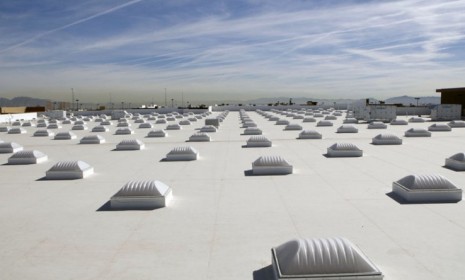Can white roofs really reduce global warming?
A new study from Stanford suggests that painting the tops of buildings and houses white could do more harm than good

Energy Secretary Steven Chu, among others, has urged Americans to paint their roofs white to reflect sunlight skyward, on the theory that this will help cool off cities and fight climate change. But Stanford University researchers have tried to quantify, for the first time, how much cities, or "heat islands," actually contribute to global warming, and they've concluded that the well-intentioned practice of whitewashing the tops of buildings might do more harm than good. Here's what they found:
How much do "heat islands" contribute to climate change?
Not much, according to this new study. Global warming skeptics say cities "are a larger contributor to global warming than the greenhouse gases produced by human activity," says Science Daily, so there's no need to take drastic steps to reduce greenhouse gases. But the Stanford researchers, led by civil and environmental engineering professor Mark Z. Jacobson, concluded that only 2 to 4 percent of the "gross global warming problem" is due to heat emitted from concrete urban heat islands. Seventy-nine percent comes from greenhouse gases, and 18 percent comes from sunlight-absorbing black carbon emissions.
The Week
Escape your echo chamber. Get the facts behind the news, plus analysis from multiple perspectives.

Sign up for The Week's Free Newsletters
From our morning news briefing to a weekly Good News Newsletter, get the best of The Week delivered directly to your inbox.
From our morning news briefing to a weekly Good News Newsletter, get the best of The Week delivered directly to your inbox.
But why are white roofs detrimental?
Using a computerized climate model, the researchers found that white roofs do cause cities to have lower surface temperatures, as they reflect sunlight back into the atmosphere. That's no shock "to anyone who's sat in a car with a black interior in the sun," says Douglas Main at Discover. The trouble is, when there's less heat at street level, less water evaporates to form clouds, which act as buffers against incoming sunlight. And that's not all: When sunlight is reflected from a white rooftop, air pollutants prevalent in cities absorb some of the heat and carry it to other areas, further limiting the cooling effect.
Then what can we do to reduce global warming?
While Jacobson says that white roofs may be a bad idea globally, installing photovoltaic solar panels to shield your home may help make a difference by absorbing sunlight, rather than reflecting it back into the air to be absorbed by pollution. Plus, the panels create clean-running electricity, further reducing our reliance on fossil fuels.
A free daily email with the biggest news stories of the day – and the best features from TheWeek.com
Sources: Discover, Science Daily, Smart Planet
-
 Joanna Trollope: novelist who had a No. 1 bestseller with The Rector’s Wife
Joanna Trollope: novelist who had a No. 1 bestseller with The Rector’s WifeIn the Spotlight Trollope found fame with intelligent novels about the dramas and dilemmas of modern women
-
 Codeword: December 20, 2025
Codeword: December 20, 2025The daily codeword puzzle from The Week
-
 Crossword: December 20, 2025
Crossword: December 20, 2025The daily crossword from The Week